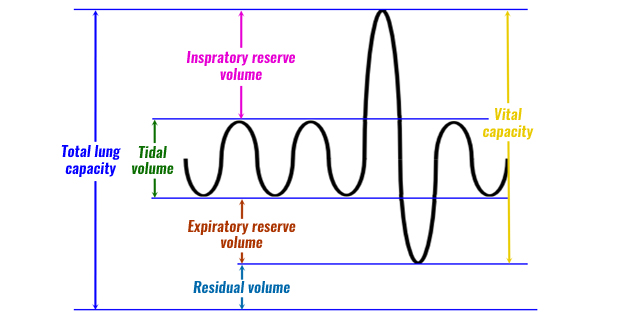1.2 The Respiratory System
1/35
Name | Mastery | Learn | Test | Matching | Spaced |
|---|
No study sessions yet.
36 Terms
Diffusion
The movement of particles from an area of high concentration to an area of low concentration
Gaseous Exchange
The movement of oxygen from the air into the blood, and carbon dioxide from the blood into the air
Ventilation
air in and out of lungs
External Respiration
Gaseous exchange between lungs and blood
Internal Respiration
Gaseous exchange between capillaries and body cells
What are structures of alveoli that assist gaseous exchange
Walls are 1 cell thick - short diffusion pathway
Extensive capillary network - lots of blood supply allows quick transport
Large surface area - greater uptake of oxygen
Mechanics of breathing in Inspiration
Diaphragm - contracts (flattens)
Ribcage - moves up and out
Muscles used at rest - diaphragm, external intercostals
Muscles used in exercise - Diaphragm, External intercostals, Sternocleidomastoid, Scalenes, Pectoralis major
Volume - Increase
Pressure - Decrease
Air - Air rushes in
Mechanics of breathing in Expiration
1.Diaphragm - Relax (dome shape)
2. Ribcage - Moves down and in
3. Muscles used at rest - (passive) Diaphragm + External intercostal relax
4. Muscles used in exercise - Internal intercostals, Abdominals contract
5. Volume - Decreases
6. Pressure - Increases
7. Air - Air rushes out
Tidal Volume
Volume of air breathed in or out per breath
Tidal Volume during exercise
Increases - more oxygen required so depth of breathing increases. Also more inspiratory/expiratory reserve volume used.
Inspiratory Reserve Volume
Volume of air that can be forcibly inspired after a normal breath
Expiratory Reserve Volume
Volume of air that can be forcibly expired after a normal breath
Inspiratory/Expiratory Reserve Volume during exercise
Decreases
Residual Volume
The amount of air that remains in the lungs after maximal expiration
Residual Volume during exercise
Stays the same - held permanently by rings of cartilage
Minute Ventilation
Volume of air breathed in and out per minute
Minute Ventilation during exercise
Increases - more demand leads to breathing increases
Spirometer
A device used to measure the volume of air inspired and expired by lungs

Gaseous Exchange purpose
Oxygen into lungs so that it can diffuse into blood and be transported round the body
Remove carbon dioxide from blood
Partial Pressure
Pressure exerted by an individual gas when it exists in a mixture of gases
Gaseous exchange at alveoli
PP of oxygen is higher at alveoli then pp in capillaries
Therefore, oxygen will diffuse from alveoli to capillaries
(Reverse for CO2)
Gaseous exchange at muscles
PP of oxygen at muscles is lower then pp in capillaries
Therefore, oxygen will diffuse from capillaries to muscles
(Reverse for CO2)
Oxygen diffusion pathway
Alveoli
Blood
Muscles
Carbon dioxide diffusion pathway
Muscles
Blood
Alveoli
Diffusion gradient
Explains how gases flow from an area of high to low concentration
3 Factors involved in regulation of breathing
Neural control
Chemical control
Hormonal control
Sympathetic nervous system
Increase breathing rate to prepare body for exercise
Parasympathetic nervous system
Lower breathing rate
What regulates breathing rate
The respiratory centre located in the medulla oblongata and uses neural and chemical control
Inspiratory centre
Responsible for inspiration and expiration
Inspiratory Centre pathway for inspiration
Receptors
Medulla
Phrenic nerve
Diaphragm + external intercostals
Expiratory centre
Stimulates expiratory muscles during exercise
Factors that affect Neural Control of breathing
Mechanical factors - proprioceptors located in joins and muscles provide feedback to respiratory centre to increase breathing during exercise
Baroreceptors - detect decrease in blood pressure in aorta and carotid arteries which increases breathing rate
Stretch receptors - prevent over inflation of lungs by sending impulses to the expiratory centre and then down intercostal nerves (abdominal + internal intercostals) allowing expiration
Hormonal control of breathing
1.Before exercise, brain sends impulses to renal glands 2. This pumps adrenalin into blood (demand for more o2 + co2) 3. This increases breathing rate
Lack of exercise + poor diet
Reduced cardiovascular endurance - inefficient gas exchange
Smoking effects
Reduces number of alveoli____- inefficient gaseous exchange
Nicotine constricts bronchioles - increase breathlessness
Carbon monoxide binds to haemoglobin rather then o2 - affects o2 transport to muscles = fatigue
Damages cell lining in trachea, bronchi , bronchiole - excess mucus leading to coughing and worse inhalation/exhalation